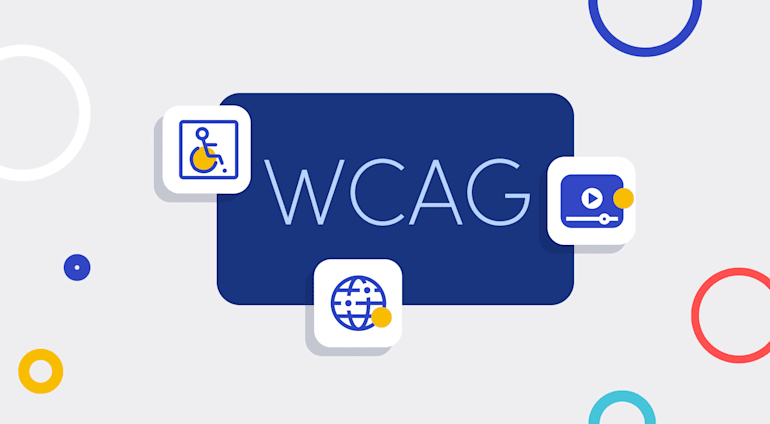“Holistic accessibility … provide[s] people with disabilities the best chance to achieve equality.” — Sheri Byrne-Haber
As digital technology advances, video is gaining popularity across industries, replete with entertaining, engaging, and coherent content. All too often, however, not everyone can access it for various reasons.
Built-in accessibility for video, which means enabling people of various auditory, movement, sight, and cognitive abilities to understand and enjoy it, is essential for maximizing your channel’s growth potential. This article suggests ways in which to make video accessible to the disabled so that your brand can reach the broadest possible audience while embracing inclusivity.
WCAG and Other Best Practices
An excellent point of reference is the two-decade-plus-old Web Content Accessibility Guidelines (WCAG), which offer the following:
- Pointers for determining the accessibility aspects of your video content.
- Precise technical specifications and management guidance for content creators.
- Tips for building a better and more unifying standard that directly benefits viewers with accessibility issues.
Many media platforms, including Cloudinary, have adopted WCAG while advocating the creation of engaging visual experiences.
Below are WCAG’s five main considerations for planning, recording, storyboarding, scripting, and producing video and audio.
Avoid Causing Seizures
When storyboarding, take into account viewers with epilepsy, i.e., those with photosensitivity seizure disorders who could suffer convulsions while watching video that flashes at certain frequencies for rendering. Eliminate content that flickers more than three times within one second over any area of the screen.
Consider Speaker Visibility
Many people derive an understanding of speech by watching mouth movements. So, where feasible, ensure that the face of whoever is talking is visible and in plenty of light. That technique can also sharpen receptive communication skills since gestures can transmit messages soundlessly.
Ensure Readability of Overlay Text
Make overlay text readable for the audience by heeding the font family, size, and contrast between the text and background colors. That way, those with moderately low vision can read it.
Keep in mind that people with low vision often cannot read text that does not contrast with its background. A contrast ratio of 4.5:1 is the minimum standard for regular text; 3:1, for large text, which is at least 14-point bolded and 18-point unbolded.
Incorporate Sign Language
Sign language, the native tongue of many people who are deaf or hard of hearing, is usually displayed as an overlay in the bottom right corner of videos. Add sign-language overlays to your videos to enhance accessibility. Also, place important information where it’s not obstructed by those overlays.
Sign-language overlays are invaluable for people with difficulties reading the written word—especially at the speeds at which most captions play. Others prefer to view captions and watch sign language simultaneously.
Add Audio Descriptions
Audio descriptions of visual information can be extremely helpful for vision-impaired or blind people. Make the narration clear, coherent, and easy to follow.
Other Enhancements
The above five guidelines are the minimum requirements for accessible content. You should also incorporate the other enhancements below, which would benefit all viewers.
Provide Full Transcripts
Full transcripts, which include a description of the visual information required for understanding the video content, aim to meet a wide range of needs. As a rule, those documents are of great help to viewers who have trouble watching full-length videos, those who are hard of hearing or blind, and those who access web content on screen readers.
Creating transcripts from caption files is easy with basic web skills and the appropriate tools. Cloudinary’s Google AI Video Transcription add-on is an effective one for generating transcripts and, from there, subtitles.
Add Captions and Subtitles
Individuals who find it easier to process written information than the spoken word, including those with hearing disabilities or cognitive impairments, often read captions while watching video. Captions are also handy in a loud environment that renders the video inaudible and in quiet surroundings where the viewers want to avoid disturbing others.
Hence, captions or subtitles are essential for video accessibility. Captions offer content in the same language as the audio; subtitles, in other languages than the audio. You can generate both with Cloudinary through automation.
Make Available a Keyboard
Did you know that most media players offer few capabilities that support accessibility? Ensure that your site or app leverages a compliant media player.
The user interface of accessible media players works through a speech interface after the viewer has zoomed into the page with a screen reader—without a mouse device. Therefore, media players must offer keyboard features for accessibility: playing, pausing, muting, and unmuting content through keystrokes, also cluing viewers in on those options.
Workarounds for Visual Impairments
Accessible video means that the content is reachable, operable, and robust for viewers who employ various assistive techniques and technologies. This section explains the challenges of visual impairments and the ways to overcome them.
Address Low Vision
People with low vision cannot see clearly—a disability that glasses or surgery cannot correct but that can usually be rectified with screen magnification and zoom tools. Your video must not lose content or functionality when viewed with magnification technology.
Tackle Color Blindness
Color-blind viewers cannot differentiate certain color combinations. Handling that problem does not mean that you should eliminate colors from your video, for they usually enhance the user experience, convey crucial information, or furnish entertainment. Rather, to accommodate the color-blind audience, supplement your video content at a minimum with text or captions that convey the same details.
The Essential Role of Accessibility
Besides playing a vital role in inclusion and engagement with people of all abilities, accessibility of video content also benefits them by offering more options for consuming footage.
Remember to also render supporting materials like titles, descriptions, tags, and other metadata accessible. While designing or filming content, keep all potential audiences in mind and adopt assistive technologies to serve them well.
For details on how to make video more accessible and deliver captivating media experiences, visit www.cloudinary.com.





